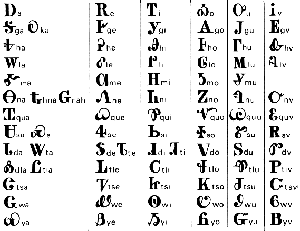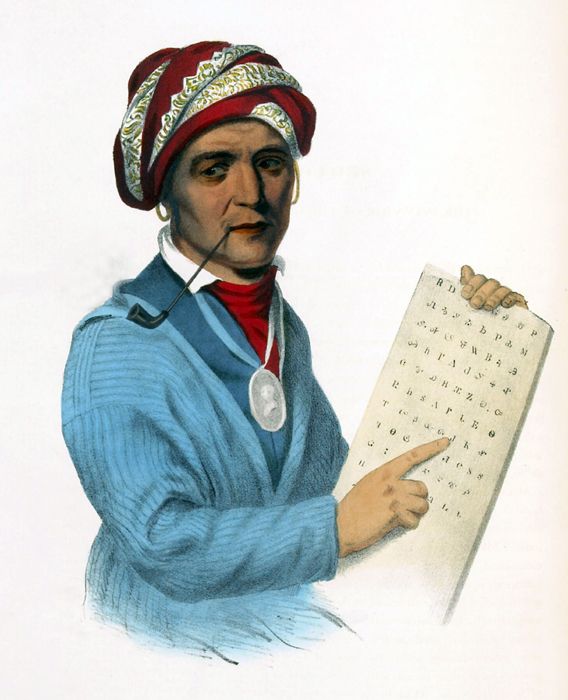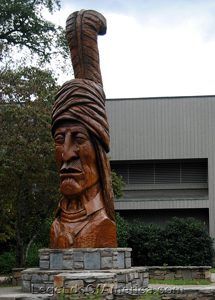Sequoyah – Inventor of Written Cherokee – Legends of America (original) (raw)
Sequoyah by Charles Bird King, 1828
Sequoyah was a famous and influential Cherokee Leader who invented the Cherokee alphabet.
Sequoyah was born to Virginia fur trader Nathanial Gist* and Wu-te-he, the daughter of a Cherokee Chief, sometime in about 1770 near the old Cherokee capital of Echota in Tuskegee (Tasgigi), now flooded by Tellico Lake. Later in life, his English name would appear as George Guess (annotation on the Treaty of 1828).
Because of an affliction in his leg, he was known among the Cherokee as Sequoyah, which translates to “pig’s foot.” Since he suffered physical limitations, Sequoyah worked as a trader and carried on his mother’s business at her trading post after her death in 1800. He would also become a silversmith and blacksmith, creating his tools.
Sequoyah was exposed to the English concept of writing early in life but never learned the alphabet. Then in 1809, after conversing with friends over the idea at his shop, he began toying with how to translate verbal Cherokee words into a written language.
His project was put on hold with the War of 1812. By October of 1813, Sequoyah had volunteered to help fight the British. He would see action in the Battle of Tallahatchie in November of 1813 and the Battle of Horseshoe Bend in March of 1814 before being discharged shortly after.

Sequoyah developed Cherokee Syllabary.
The following year, he married Sally Waters of the Bird Clan and continued working on creating a written language for his people. He quickly realized that creating a symbol for every word would be almost impossible, so instead, he started paying more attention to the sounds that made up the words.
He discovered 85 syllables in the language and then created symbols to be used in combinations for each word. He would first teach his brother-in-law, Michael Waters, before turning to his daughter, A-Yo-Ka, who became the first to read and write with his invention.
In 1821, using his daughter as an example, he presented his invention to the tribe. They both were promptly charged with witchcraft, but luckily an 1811 Cherokee law provided them a civil trial before execution. The warriors brought in to judge the case were given demonstrations of A-Yo-Ka sending written messages to her father, finally convincing them that the symbols on paper represented their verbal language. Within a week, the warriors could read and write, and the new Cherokee syllabary quickly spread.
In 1822 Sequoyah headed to present-day Arkansas to begin teaching the written language. In 1824 the General Council of the Cherokee Nation voted to give him a silver medal in honor of his creation. By 1825 much of the Christian Bible had been translated into Cherokee, and in 1827 it was used to write the Constitution of the Cherokee Nation. In 1828 the first national bilingual newspaper, the “Cherokee Phoenix,” was published.
Sequoyah would also be awarded $500 by the U.S. Government in a January 1828 treaty, along with land in present-day Sequoyah County, Oklahoma. In 1829, as part of the Indian relocation, he and 2500 Cherokees moved to Indian Territory (Oklahoma) in exchange for land they had occupied in Arkansas. He would build a log cabin near Sallisaw, Oklahoma, which remains a National Historic Landmark today.
Statue of Sequoyah in North Carolina. Photo by Kathy Alexander.
Sequoyah would continue his teachings but died in August 1843 near San Fernando, Mexico, while on a trip to villages in Texas. During the trip, his group was robbed of their supplies and horses north of San Antonio. Finding shelter in a cave, his party left him to try to secure replacements. Weeks passed, during which Sequoyah was forced from the cave by floodwaters. When he was finally found, he had suffered greatly. The party then took him to the Mexican village, where he died. The Cherokee Nation wouldn’t be notified of his death for two years.
Sequoyah’s invention would bring literacy to the Cherokee people and ensure the tribes’ history wouldn’t be lost. It continues to be used today. He has been honored with a monument in Georgia, a bronze panel at the Library of Congress, the monument seen here in Cherokee, North Carolina, and a 1980 nineteen-cent stamp by the United States Postal Service. The Sequoyah Birthplace Museum in Vonore, Tennessee, tells the story of his life.
© Kathy Weiser-Alexander/Legends of America, updated May 2023.
*Note: It is also argued that his father was George Gist, a German peddler.
Also See:
Chief John Ross of the Cherokee Nation
Sources:
Cherokee Nation
Library of Congress
Sequoyah Birthplace Museum
Wikipedia

